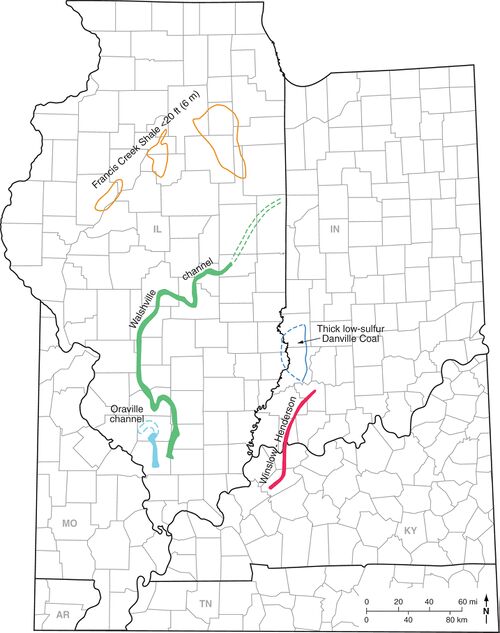Galatia Channel:Similar Channels Affecting Other Coal Seams: Difference between revisions
Jump to navigation
Jump to search
Alan.Myers (talk | contribs) No edit summary |
Alan.Myers (talk | contribs) No edit summary |
||
| (7 intermediate revisions by the same user not shown) | |||
| Line 5: | Line 5: | ||
<li style="display: inline-block;">[[File:C605-Figure-39.jpg|500px|{{File:C605-Figure-39.jpg}}|thumb]]</li> | <li style="display: inline-block;">[[File:C605-Figure-39.jpg|500px|{{File:C605-Figure-39.jpg}}|thumb]]</li> | ||
</ul></div> | </ul></div> | ||
{| | |||
|- | |||
| '''[[Galatia Channel:Colchester Coal and Francis Creek Shale|Colchester Coal and Francis Creek Shale]]''' | |||
|- | |||
| '''[[Galatia Channel:Herrin Coal, Energy Shale, and Walshville Channel|Herrin Coal, Energy Shale, and Walshville Channel]]''' | |||
|- | |||
| '''[[Galatia Channel:Baker Coal and Winslow-Henderson Channel|Baker Coal and Winslow-Henderson Channel]]''' | |||
|- | |||
| '''[[Galatia Channel:Danville Coal|Danville Coal]]''' | |||
|- | |||
| '''[[Galatia Channel:Murphysboro Coal and Oraville Channel|Murphysboro Coal and Oraville Channel]]''' | |||
|} | |||
{{Galatia Channel Page}} | {{Galatia Channel Page}} | ||
{{#set: Has parent page=Galatia_Channel:Evolution_of_a_Peat_-_Contemporaneous_Channel_-_The_Galatia_Channel,_Middle_Pennsylvanian,_of_the_Illinois_Basin}} | {{#set: Has parent page=Galatia_Channel:Evolution_of_a_Peat_-_Contemporaneous_Channel_-_The_Galatia_Channel,_Middle_Pennsylvanian,_of_the_Illinois_Basin}} | ||
{{#set:Prev_Page=Galatia Channel:Other Channels | {{#set:Prev_Page=Galatia Channel:Other Channels}} | ||
{{#set:Next_Page=Galatia Channel: | {{#set:Next_Page=Galatia Channel:Colchester Coal and Francis Creek Shale}} | ||
Revision as of 15:15, 14 July 2020
Similar Channels Affecting Other Coal Seams
Several well-documented paleochannels in the Illinois Basin existed contemporaneously with peat deposits older and younger than the Springfield (Figure 39). The Galatia channel provides an apt model for comparison.
| Colchester Coal and Francis Creek Shale |
| Herrin Coal, Energy Shale, and Walshville Channel |
| Baker Coal and Winslow-Henderson Channel |
| Danville Coal |
| Murphysboro Coal and Oraville Channel |
Primary Source
References
